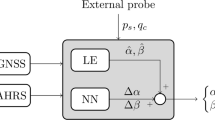Abstract
Flush air data sensing (FADS) systems have been successfully tested on the nose tip of large manned/unmanned air vehicles. In this paper we investigate the application of a FADS system on the wing leading edge of a micro (unmanned) air vehicle (MAV) flown at speed as low as Mach 0.07. The motivation behind this project is driven by the need to find alternative solutions to air data booms which are physically impractical for MAVs. Overall an 80% and 97% decrease in instrumentation weight and cost respectively were achieved. Air data modelling is implemented via a radial basis function (RBF) neural network (NN) trained with the extended minimum resource allocating network (EMRAN) algorithm. Wind tunnel data were used to train and test the NN, where estimation accuracies of 0.51°, 0.44 lb/ft2 and 0.62 m/s were achieved for angle of attack, static pressure and wind speed respectively. Sensor faults were investigated and it was found that the use of an autoassociative NN to reproduce input data improved the NN robustness to single and multiple sensor faults. Additionally a simple NN domain of validity test demonstrated how the careful selection of the NN training data set is crucial for accurate estimations.
Similar content being viewed by others
Explore related subjects
Discover the latest articles, news and stories from top researchers in related subjects.References
Andersen, D., Haley, D.: NASA tests new laser air data system on SR-71 Blackbird. NASA. http://www.nasa-usa.de/home/hqnews/1993/93-163.txt (1993). Accessed 17 September 1993
Cary, J.P., Keener, E.R.: Flight evaluation of the X-15 Ball-Nose Flow-Direction sensor as a airdata System. NASA TN D-2923 (1965)
Wolowicz, C.H., Gosett, T.D.: Operational and performance characteristics of the X-15 spherical hypersonic flow direction sensor. NASA TN D-3076 (1965)
Larson, T.J., Siemers III, P.M.: Subsonic tests of an All-Flush-Pressure-Orifice air data system. NASA TP 1871 (1981)
Larson, T.J., Whitmore, S.A., Ehernberger, L.J., Johnson, J.B., Siemers III, P.M.: Qualitative evaluation of a flush air data system at transonic speeds and high angles of attack. NASA TP-2716 (1987)
Larson, T.J., Moes, T.R., Siemers III, P.M.: Wind tunnel investigation of a flush airdata system at Mach numbers from 0.7 to 1.4. NASA TM-101697 (1990)
Whitmore, S.A., Davis R.J., Fife J.M.: In flight demonstration of a real time flush airdata sensing system. NASA TM 104314 (1995)
Rohloff, T.: Development and evaluation of neural network flush air data sensing systems. Ph.D. thesis, Dept. of Mechanical Engineering, Univ. of California (1998)
Crowther, W.J., Lamont, P.J.: A neural network approach to the calibration of a flush air data system. Aeronaut. J. 105, 85–95 (2001)
Brown, E.N., Friehe, C.A., Lenschow, D.H.: The use of pressure fluctuations on the nose of an aircraft for measuring air motion. J. Clim. Appl. Meteorol. 22, 171–180 (1983)
Wenger, C., Devenport, W.: Seven-hole pressure probe calibration method utilizing look-up error tables. AIAA J. 37, 675–679 (1999)
Rediniotis, O., Vijayagopal, R.: Miniature multihole pressure probes and their neural network based calibration. AIAA J. 37, 666–674 (1999)
Rediniotis, O., Chrysanthakopoulos, G.: Application of neural networks and fuzzy logic to the calibration of the seven-hole probe. J. Fluid. Eng.—Trans. ASME 120, 95–101 (1998)
Lu, Y., Sundararajan, N., Saratchandran, P.: Analysis of minimal radial basis function network algorithm for real-time identification of nonlinear dynamic systems. IEE Proc. Control Theory Appl. 4, 476–484 (2000)
Houghton, E.L., Carpenter, P.W.: Aerodynamics for Engineering Students. Butterworth Heinemann, Burlington, MA (2003)
Gallinari, F.: Industrial Applications of Neural Networks. World Scientific Publishing Co. Pte. Ltd., Great Britain (1998)
Haykin, S.: Neural Networks: A Comprehensive Foundation. Macmillan College Publishing Company, New York (1994)
Powell, M.J.D.: Radial basis function for multivariable interpolation: a review. In: Mason, J.C., Cox, M.G. (eds.) Algorithms for Approximation, pp. 143–167. Clarendon Press, Oxford (1987)
Chen, S., Cowan, F.N., Grant, P.M.: Orthogonal least squares learning algorithm for radial basis function networks. IEEE Trans. Neural Netw. 2, 302–309 (1991)
Platt, J.C.: A resource allocating network for function interpolation. Neural Comput. 3, 213–225 (1991)
Kadirkamanathan, V., Niranjan, M.: A function estimation approach to sequential learning with neural networks. Neural Comput. 5, 954–975 (1993)
Fravolini, M.L., Campa, G., Napolitano, M., Song, Y.: Minimal resource allocating networks for aircraft SFDIA. Adv. Intell. Mechatron. 2, 1251–1256 (2001)
Courrieu, P.: Three algorithms for estimating the domain of validity of feedforward neural networks. Neural Netw. 7, 169–174 (1994)
Helliwell, I.S., Torega M.A., Cottis, R.A.: Accountability of neural networks trained with ‘Real World’ data. In: Artificial Neural Networks, Conference Publication No. 409 IEE, pp. 218–222. 26–28 June (1995)
FAA: Unmanned Aircraft Systems (UAS) Certifications and Authorizations. US Dept. of Transportation. http://www.faa.gov/aircraft/air_cert/design_approvals/uas/cert/ (2007). Accessed 5 November 2007
mini vane. SpaceAge Control. http://www.spaceagecontrol.com/pm/uploads/Main.Adpmain/100386.pdf (2008). Accessed 13 February 2008
Author information
Authors and Affiliations
Corresponding author
Rights and permissions
About this article
Cite this article
Samy, I., Postlethwaite, I. & Gu, D. Subsonic Tests of a Flush Air Data Sensing System Applied to a Fixed-Wing Micro Air Vehicle. J Intell Robot Syst 54, 275–295 (2009). https://doi.org/10.1007/s10846-008-9266-x
Received:
Accepted:
Published:
Issue Date:
DOI: https://doi.org/10.1007/s10846-008-9266-x




